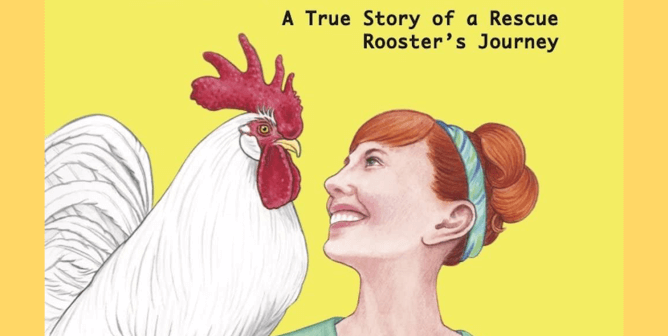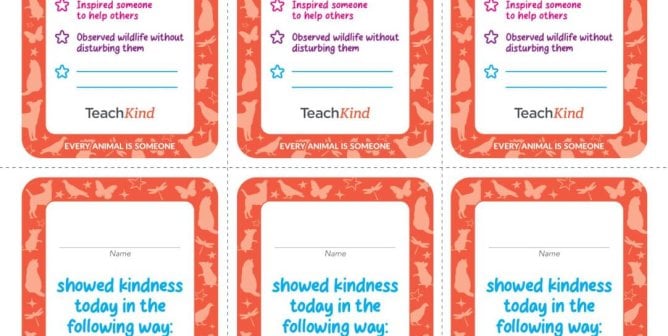Sheldon Hears a Squeak: Encouraging Compassion for All (Reader’s Theater)
Would you like to give students a chance to use their energy and voices as storytellers? Reader’s theater is a great way to help them develop reading fluency and build reading confidence. Students practice reading aloud with expression, conveying a message through their vocal tone, facial expressions, and gestures.
Creative outlets such as theater can enhance a student’s educational experience in many ways. Acting out stories can help students form a deeper understanding of a text and develop a love of reading. Theater also fosters empathy, because it calls on them to enter the mind of a character and ask themselves what that character is thinking or feeling. This activity will encourage them to expand their compassion to all animals and treat others with respect.
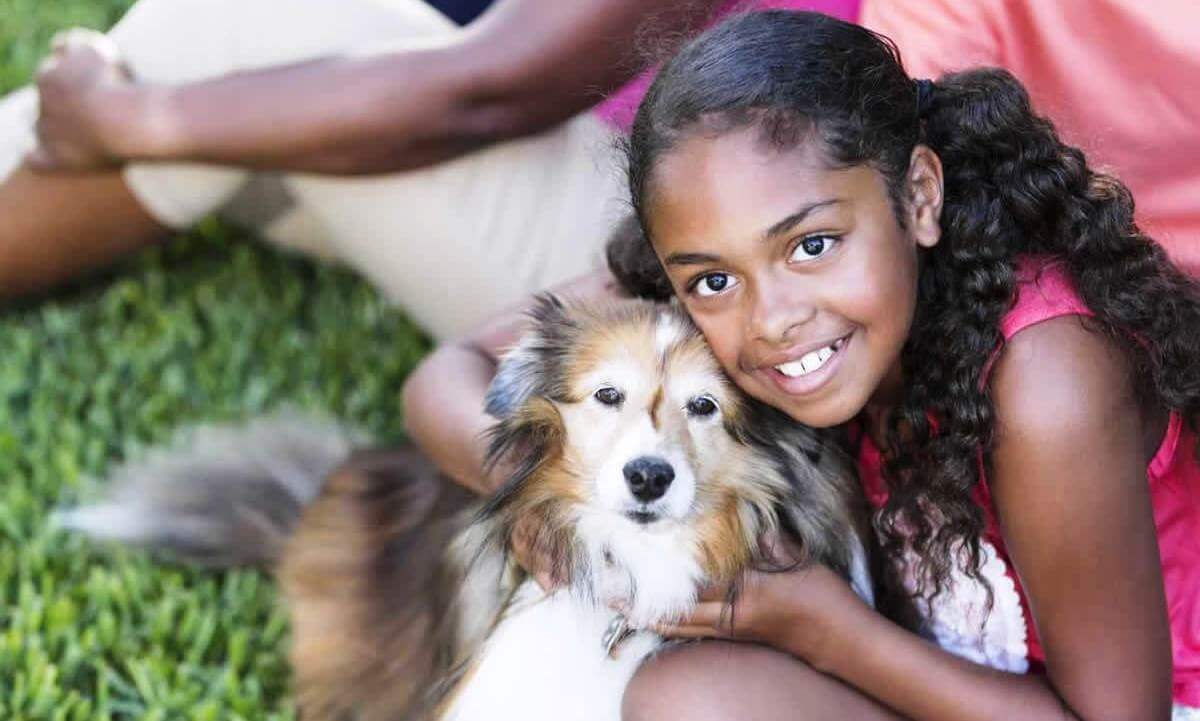
“Sheldon Hears a Squeak” tells the story of a compassionate boy named Sheldon who speaks up for all sentient beings. Teachers can use the teacher’s guide (see below) to lead a classroom discussion about the theme of the story and reasons why it’s important to be kind to all animals.
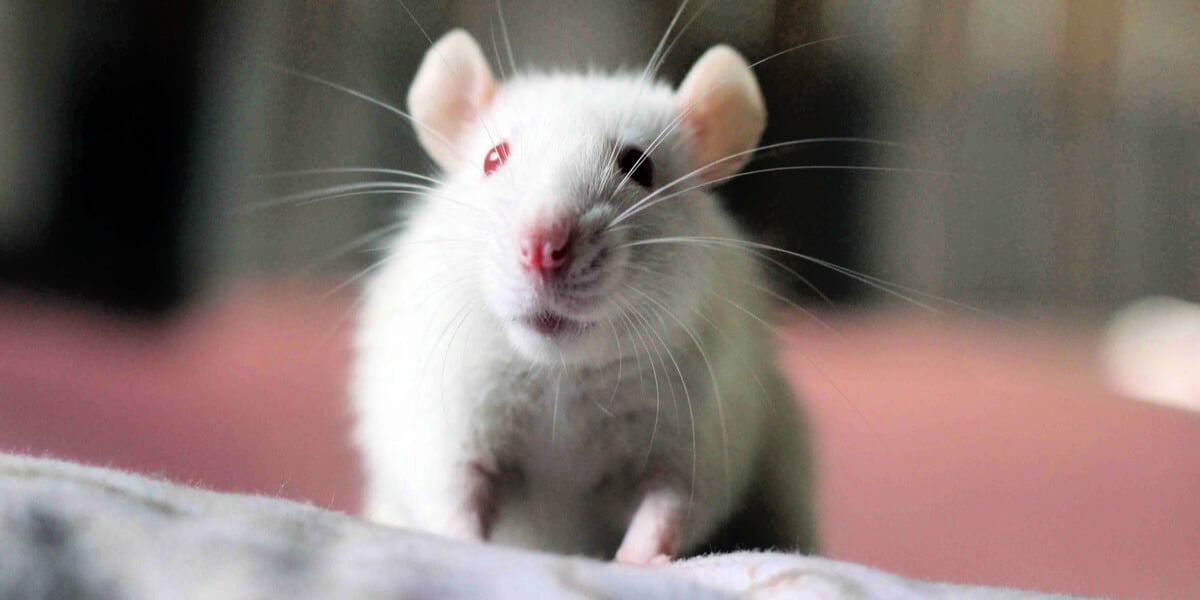
Shadow theater is a display in which the shadows of flat puppets are cast on a screen. The show is viewed by an audience on the other side of the screen. This allows students to explore with shadow and light to bring a story to life. Students will learn about the relationship between light and shadows through hands-on experimentation. They will further their understanding of the effect that proximity to a light source has on the size and length of shadows. They will also learn the various effects of light on translucent and opaque materials. This activity will foster your students’ curiosity about light, shadows, and the world around them.
Distance-Learning
And if you’re using this lesson as part of a distance-learning program, students can take turns reading parts of the script during your virtual class meetings. This activity only requires some readily available materials that children can use to construct the puppets and stage at home and then telecast their performance to their classmates on the virtual platform.
Materials
- Cardboard or thick paper to cut puppets out of (can be recycled materials, like empty cereal or tissue boxes)
- A light source (can be a flashlight or a projector light)
- A screen (can be a thin sheet hung from the ceiling or a trifold poster board with a rectangle cut out of the center and a sheet of white banner paper taped over the hole)
- “Sheldon Hears a Squeak” script
- Puppet templates
- Popsicle sticks
- Scissors
- Pencil
- Paper fasteners (optional—for adding movable parts to the puppets)
- “Sheldon Hears a Squeak” vocabulary list
- “Sheldon Hears a Squeak” teacher’s guide (see below)

Directions
Make the Puppets
• Print and cut out the puppet templates.
• If a recycled box is being used, cut all the edges so that it lies flat.
• Lay the template on the cardboard and trace it.
• Cut the puppet out of the cardboard.
• If using one of the templates with movable pieces, attach the limbs or tail to the body with paper fasteners. Make sure they’re tight enough to be secure but still allow the limbs to be moved easily
• Attach a Popsicle stick to the base of each puppet. If the limbs and tail are attached with paper fasteners, also attach a Popsicle stick to each one so that they can be moved.
• Complete these steps for all three puppets.
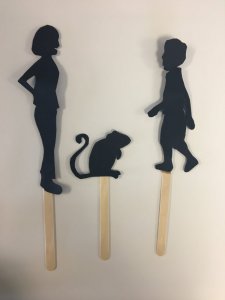
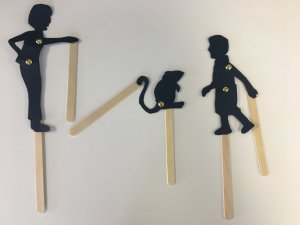
Make a Stage
• Option 1: Suspend a thin sheet from the ceiling or from wall to wall draped over a rope or cord.
• Option 2: Cut a rectangle out of the center of a trifold poster board. (The rectangle will be where the puppets’ shadows are projected.) Cut a strip of white banner paper large enough to cover the hole. Tape the strip of banner paper over the hole.
• Option 3: Tape together about five pieces of white printer paper to make a screen. Get creative—you can decorate your stage or add curtains.
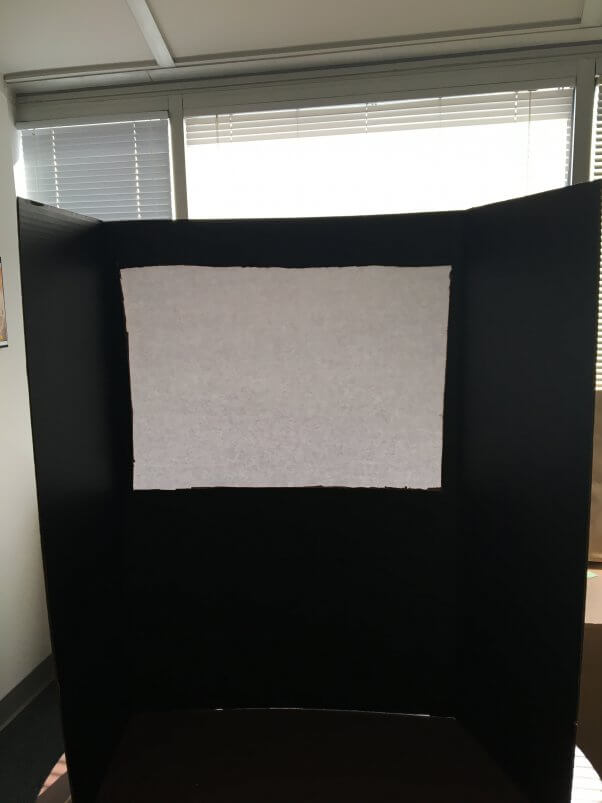
Create a Shadow Theater
• Place your light source behind the cutout in your stage. (If it’s a flashlight, have someone hold it in place.)
• Students working the puppets can stand behind the screen to the side or underneath the light source and hold the puppets in front of the light.
• The puppet’s shadows will then be projected onto the screen for the audience to see.
• Students can use the Popsicle sticks to move the puppets and their limbs.
• Puppets will appear bigger when they’re held closer to the light source and smaller when they’re held further away.
• Students should manipulate the puppets according to the action taking place in the script.
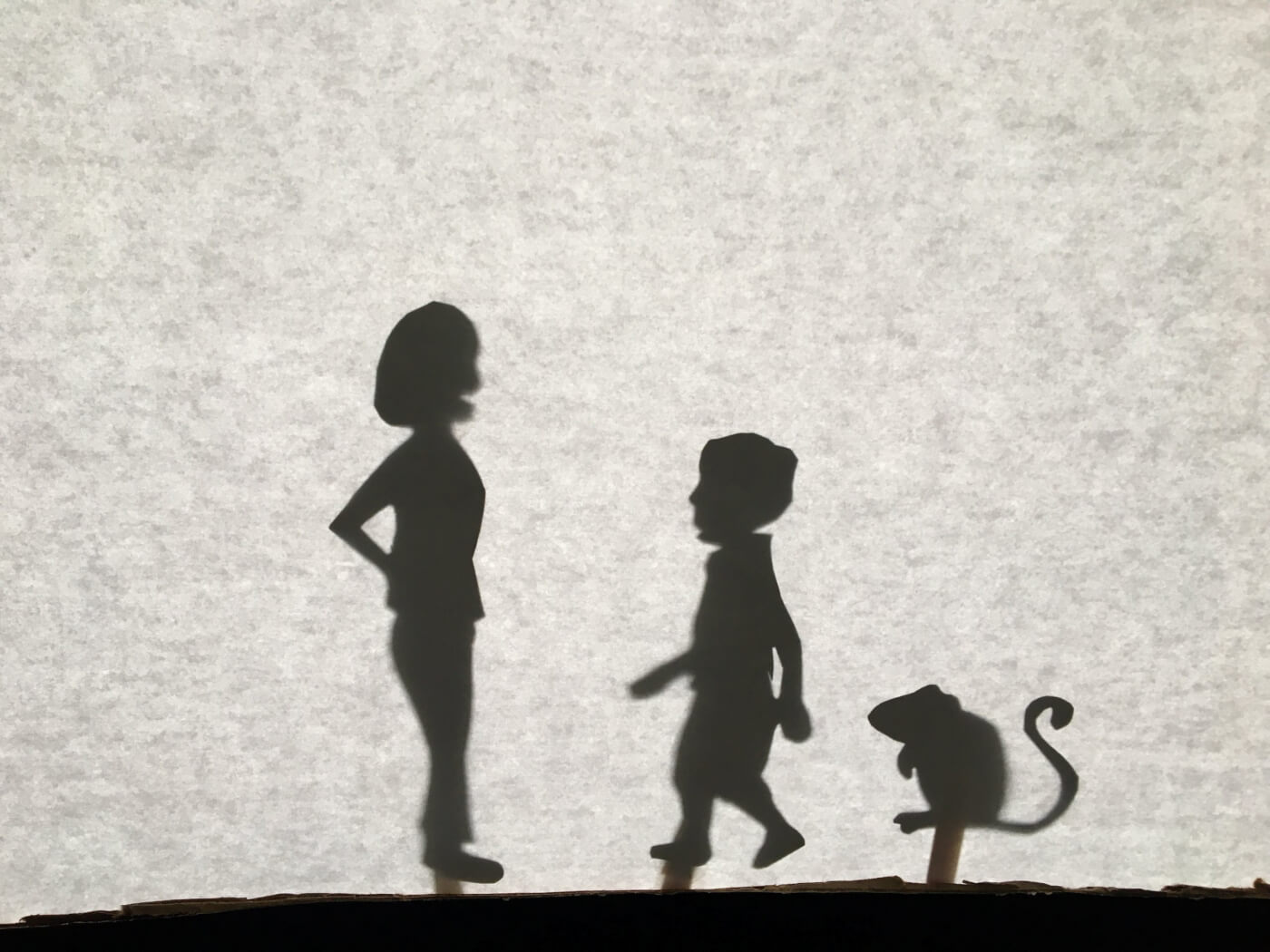
‘Sheldon Hears a Squeak’ Teacher’s Guide
Before reading the script aloud to students, ask them what they know about mice and what they normally do when they see one. Sadly, many children are conditioned from a young age to view mice in a negative light. “Sheldon Hears a Squeak” offers a great opportunity to encourage students to be compassionate and to consider the consequences of their actions on animals.
The rhyming text is enjoyable, so it may be a good idea to read it all the way through first without stopping so that students can appreciate the overall sound of the story. Then read it aloud a second time and pause at appropriate places to ask the discussion questions below.
Important note: In the story, Sheldon feeds the mouse in his house. Teachers should address this in the same way that they would any other made-up story, i.e., discuss with students what to do if there’s a real mouse in their house. Explain that children should not feed mice because they can overpopulate and end up damaging electrical wires and that their family can humanely evict “mouseguests” with a live trap. Snap traps and glue traps should never be used—both cause mice to suffer.
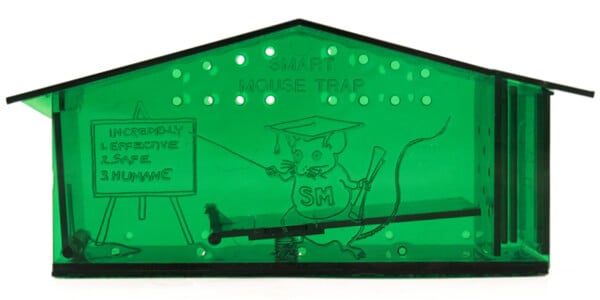
Discussion Questions
Use these questions to help students learn about mice and to inspire compassion for all animals.
Sheldon’s mother says, “Relate to that dirty thing—oh, please! Maybe I’d try if I wanted a disease.”
1. Are mice clean?
Answer: Yes, mice are very clean animals. Like cats and rabbits, they groom themselves several times a day.
2. Do mice carry diseases?
Answer: Mice are less likely than dogs and cats to catch or spread diseases.
3. Why do you think it’s important not to call mice names like “dirty” or “diseased”?
Answer: When we call them names, we spread false information about them and cause people to think about them in a negative way. Instead, we should tell people how clean, affectionate, and smart they are.
4. How is this similar to not spreading rumors about other people?
Answer: Rumors are often untrue and can be very hurtful. They can make people think poorly of others before they even get to know them.
Sheldon says, “She loves her family—I swear that it’s true. She loves them the same way that I love you.”
5. Do mother mice love their babies?
Answer: Yes. Just like human mothers, female mice love their babies and will do anything to protect them.
6. Are mice affectionate?
Answer: Yes. Mice enjoy being with other mice. They become attached to each other, love their families, and can bond with humans who are kind to them. They return as much affection as is given to them.
7. Do mice form friendships?
Answer: Yes. They play together, wrestle, and sleep curled up together. Like us, they can become lonely, scared, and sad when they’re all alone.
8. How does the mouse in the story show that she loves her babies?
Answer: She cares about their needs. She built a nest for them and tried to find them food. She was brave and spoke up to defend them when their home was in danger.
9. How is this similar to ways that you and your family show your love for each other?
Answer: Parents or guardians work hard to give children what they need. They make sure they have food and shelter. Families also speak up for each other and help each other out.
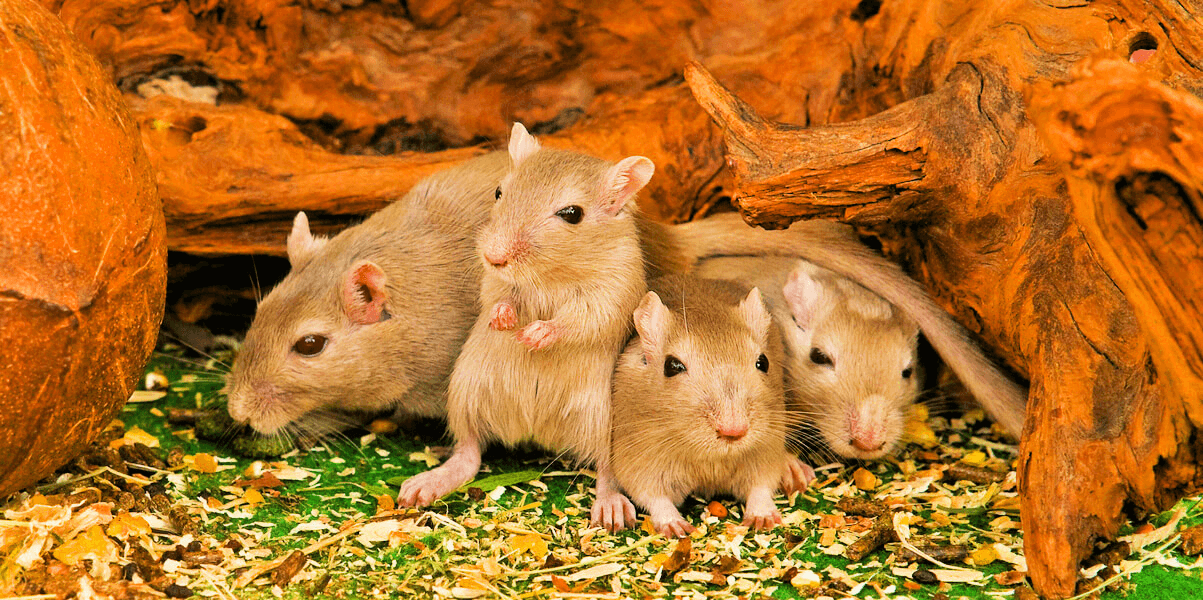
Sheldon speaks kindly to the mouse and knows she needs help.
10. Do mice speak?
Answer: Humans don’t always understand what mice are trying to say, but they do speak to each other. They use their voice to make high-pitched sounds that we can’t hear, even sometimes “singing” like birds. They also use touch and smell to communicate.
11. How do the animals you know communicate with you?
Answer: Dogs, for instance, may sit by the door when they want to go outside or sit by their bowls if they’re hungry or thirsty. They may also jump up on someone or nudge their hand when they need some love and want to be petted. And they may walk away when they want to be left alone.
12. How can you speak up for animals when their needs are not being meet?
Answer: If you see an animal in need, you should always tell a trusted adult. You can also stand up for animals by letting others know how important it is to be kind to them.
Sheldon’s mother says. “Come on, now, and let’s be reasonable. A brain in that tiny head isn’t feasible.”
13. Are mice smart?
Answer: Yes. Mice are great at learning and understanding concepts. Even though they’re much smaller than dogs, they’re just as smart! They also have excellent memories.
14. Can we assume that someone isn’t smart if they don’t look or act like us?
Answer: No. Don’t judge a book by its cover. Being different isn’t a bad thing. Birds are different from us because they can fly, but humans wouldn’t want to be thought of as less intelligent because we can only walk. We should appreciate each other’s unique qualities and remember our similarities. All animals can feel pain, love, and joy, and they all deserve respect.
15. What are some positive traits of other animals besides mice?
Answer: Pigs are smart and playful. Rabbits are curious and careful. Cows are good friends and loving mothers. Chickens are also good mothers—they sing to their chicks while they’re still inside the egg and even begin teaching them before they hatch.
Sheldon tells his mother, “I think you could relate to her, if only you’d try.”
16. In what ways are mice and humans similar?
Answer: Mice and humans talk to and love their friends and families. Both species like to play and have fun and deserve to be treated kindly.
17. Do mice have feelings, too?
Answer: Yes. They feel a wide range of emotions, just like us.
18. Why is it important to speak up for mice and all other animals?
Answer: As kind people, it’s our job to show others how to respect all animals and to make the world a better place for them. When Sheldon teaches his mother more about mice and how they feel, she realizes that she should show the same kindness that she would show Sheldon or a dog or cat. Just as Sheldon’s mother has a hard time relating to the mouse at first, sometimes people have a hard time seeing the similarities between themselves and other animals. We may be able to relate to each other or our cats or dogs but struggle to relate to animals we’ve spent less time with, like mice, cows, pigs, and chickens. Once people get to know these animals, they see that they’re smart, playful, and loving. They also see that like the mouse who had the important task of finding food for her family, all animals’ lives are valuable and they’re all important members of their families and communities.
19. Why is it important to be kind to all animals?
Answer: Like the mouse in the story, all animals are individuals with their own personalities and needs. They experience the same emotions that we do, such as love, pain, and fear. We would want to be treated with respect, so we should treat others with respect, too.
Teach Students How to Be Kind to Animals
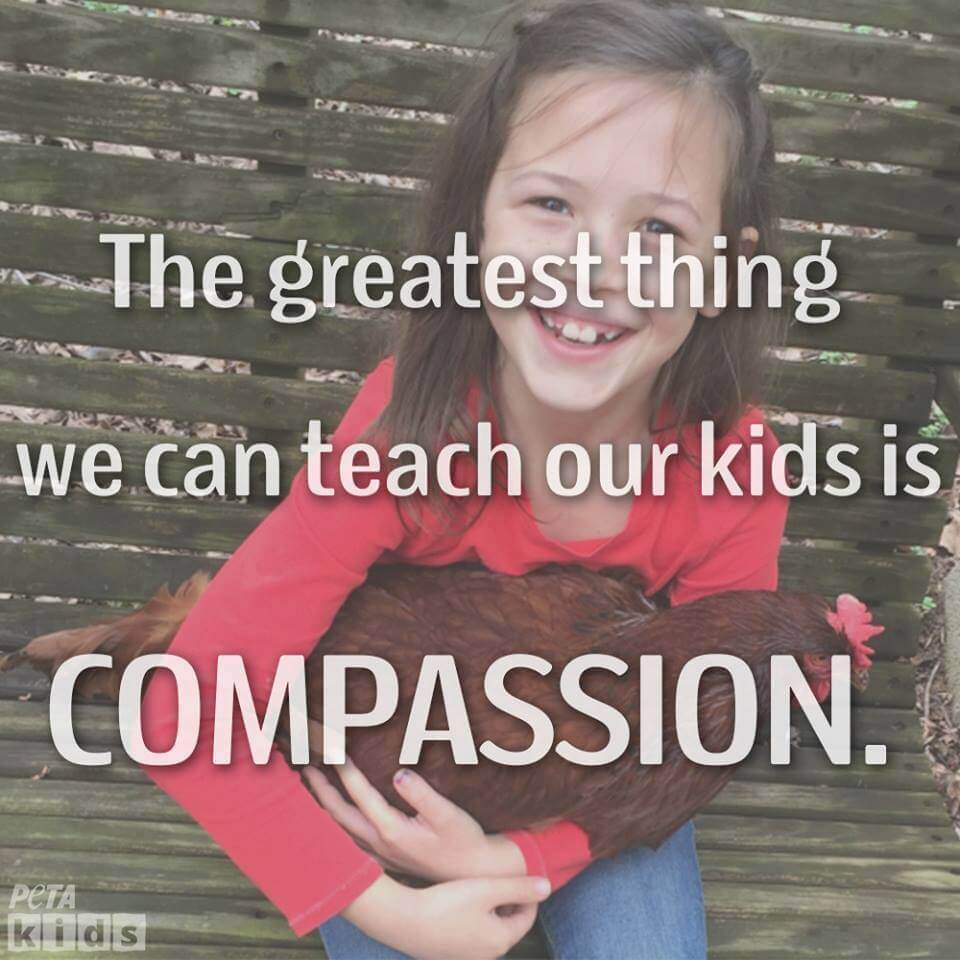 Ask students what they can do to be like Sheldon and treat animals with kindness. Use the following examples to discuss ways they can help animals in their daily lives.
Ask students what they can do to be like Sheldon and treat animals with kindness. Use the following examples to discuss ways they can help animals in their daily lives.
What can you do to be like Sheldon and treat animals with kindness?
- Take good care of your animal companions. Dogs, cats, and other animals deserve the same love, care, and respect as any other members of the family. They’re individuals with unique personalities. You could spend more time playing and cuddling with your dog or cat.
- Be kind to all animals we share the planet with. All wildlife, including frogs and turtles, should be observed from a distance and allowed to live in peace—don’t try to catch them and bring them indoors. We shouldn’t chase pigeons because it scares them, and we don’t need to squash bugs, either.
- Adopt an animal instead of buying one from a pet store or breeder. There are lots of animals in open-admission shelters who are in need of a loving home. Every time someone buys an animal, another one in a shelter loses a chance at finding a home.
- Eat lots of fruits, vegetables, and other vegan foods. Each person who goes vegan (decides not to eat meat, eggs, or dairy) saves the lives of nearly 200 animals every year!
- Go to parks instead of roadside zoos or circuses. All animals want to be free to spend their lives with their families and friends. Roadside zoos, aquariums, petting zoos, and circuses take animals away from their families and keep them in places that don’t allow them the freedom to enjoy their lives. Animals held captive like this often feel sad, frustrated, and stressed—just as you would if you were locked in your room for your whole life.
- Ask your parents to buy only products that are cruelty-free, not tested on animals.
Some products like shampoo, conditioner, soap, and makeup are tested on animals like rats, mice, rabbits, dogs, and cats. This is very scary and painful for the animals—and it’s not good science, either. There are many companies that use humane, animal-free methods to test ingredients and products. You can ask your parents to use PETA’s cruelty-free shopping guide, and you can help by looking for PETA’s “bunny logo” on products. This logo means that the product hasn’t been tested on animals:

- Leave mice alone or use a humane mouse trap that won’t hurt them. Mice just like the one in the story come into houses looking for shelter and food. They just want to live and are not dangerous or dirty. If you want to get a mouse out of your house, you should use a humane trap that catches mice without harming them—and be sure to check it hourly so that a mouse won’t be trapped in it for a long time without food or water. Never use a snap trap or a glue trap—these hurt and kill mice. Glue traps are also very harmful to animals like birds who may become stuck to them.
Reader’s Theater Step-by-Step Instructions

Plan and Prepare
1. Make copies of the script for all students.
2. Make puppets for each group. (See instructions above.)
3. Set up a light source and a screen onto which the puppets can be projected.
4. Choose seven students to assist you in modeling the procedure.
5. Have four students each read a role in the script and three students manipulate the puppets along with the script.
6. Give students enough time to read the script and practice with the puppets before starting the activity.
Introduce Shadow Puppets Reader’s Theater
1. Explain to students that they will be participating in an activity to help them better understand characters in different stories. Tell them that they’ll read script for a play, divide into groups, and practice reading a character’s lines. Then they’ll perform the play for the class using puppets.
2. Ask students if they’re familiar with scripts—what they look like, their purpose, and when they’re used. Make sure students understand that scripts are used when writing plays, movies, and television shows. They’re mostly dialogue, but they may also include stage directions or directions for the characters.
3. Ask students if they’re familiar with shadow puppets and if they’ve ever made them before. Explain how puppets can be used to act out a story.
4. Tell students that they’ll each be assigned the role of a character or the role of controlling a puppet. Once they have their role, explain to them that they’ll need to read and practice their part several times so that when they perform for the class, they’ll sound as though they’re speaking naturally rather than reading or they’ll know exactly when to manipulate their puppet. They’ll also practice with the other members of the group so that they sound as though they’re having a conversation and so that they can cooperate to move the puppets in a way that tells the story.
5. Encourage students to speak clearly in an appropriate volume, read the text with the correct pronunciation and expression, move the puppets in accordance with the script, cooperate with each other during rehearsal time, and use their rehearsal time wisely.
6. Ask students to read a sentence written on the board (e.g., “Today we’re going to a party.”) demonstrating appropriate volume and pronunciation. They can try it sounding happy, sad, confused, etc.

Modeling the Procedure
1. Ask your student helpers to join you at the front of the classroom. Read the character introductions and the setting in the script.
2. Model a rehearsal. Assign each student a role to read or a puppet to use, and suggest that each student say the first line to make sure everyone is using appropriate volume levels.
3. Have everyone read their lines aloud in the order in which they appear in the script. Model reading a word incorrectly and having another person politely correct it. Once everyone has read through the lines, model thanking the group members who helped with words you may have pronounced incorrectly, and emphasize the importance of correct pronunciation.
4. Go through the script again with students reading their lines, but this time group members will pay attention to everyone’s expression. Encourage group members to stop after everyone has read two or three lines and ask if they’re using correct pronunciation and expression. Model giving compliments to group members (e.g., “I liked the way you showed curiosity” or “The way you said that part was great—it made me feel really sad.”).
5. Demonstrate how to use the puppets. Show students how to manipulate the puppets in accordance with the script. Demonstrate how they can make them appear larger by moving them closer to the light source or smaller by moving them further away. Show students how to hold the puppets steady and move them slowly so that the shadows look clear—and how they can crouch below or stand to the side of the screen so that their own shadows don’t obscure those of the puppets. Show how multiple puppets can interact with each other to tell the story.
6. Have the students who were assigned puppets try moving them along with the corresponding lines being read. Encourage group members to ask whether the way they moved their puppet matched the story. Model giving compliments to group members, such as when students hold their puppets the proper distance from the light source.
7. Once everyone has manipulated their puppets along with the script as it’s being read aloud, suggest that students practice collaborating with the other group members to act out dialogue with the puppets. Demonstrate how group members can work together in a way that allows for multiple puppets to be projected on the screen at one time in order to act out conversations. Have students who were assigned characters in the script read some lines of dialogue while those who were assigned a puppet manipulate the puppets accordingly. After they complete the dialogue, encourage group members to ask whether they moved their puppets appropriately in relation to the others on the screen. (e.g., “Was my puppet’s shadow too small?” “Did my puppet get in the way of yours?”). Model giving compliments to group members.
Recap and Review
1. Ask if they have any questions about what they should do when they’re in their groups.
2. Finally, read through the whole script together, using appropriate volume, pronunciation, and expression and students moving the puppets along with the story.
Guided Practice
1. Assign students to groups. Have group names written on the scripts and puppet sets, with roles already assigned before class begins in order to ease the transition and keep students on task for the first few classes using reader’s theater. Also, tell the groups where in the room they’ll meet to practice their various roles.
2. Tell students that they’ll have 25 minutes to practice and that you’ll be checking in on them and tracking their progress. Set a timer.
3. Walk around the classroom. Sit with different groups of students and listen to them read the script and watch as they practice with the puppets. Provide praise and other feedback on students’ reading, expression, and interactions with each other.
4. Ask the students for their attention when the timer beeps. Check to see if each group completed the script at least once by having them give a thumbs-up or thumbs-down.
5. Tell the students that when the next class begins, they’ll have an opportunity to practice with their group again before they perform. Collect the scripts and puppets, and elicit feedback about the aspects that students liked best. Focus on the positive.
Performance
1. Review the importance of speaking clearly and using appropriate volume, reading the text with the correct pronunciation and with expression, moving the puppets in accordance with the lines in the script, cooperating with each other during rehearsal time, and using their rehearsal time wisely.
2. Ask students to get into their groups, and pass out the scripts and puppets. Depending on your class scheduling, block off enough time for both practice and group performances. Remind students how much time they have to practice, and use the timer.
3. Rotate through the groups in order to answer any questions and ensure that students are prepared to perform.
4. Call the class back together when the timer beeps. Groups can stay seated together, but remind them to give the performers their attention. Tell students that their group numbers are in a basket. Explain to them that when their group number is called, each student should move to the screen and get in place to perform.
5. Ensure that every group has a chance to perform.
6. Discuss with the groups and the whole class the strengths of each performance as well as any suggestions for improvement.
‘Sheldon Hears a Squeak’:
Use these questions to discuss the theme of compassion for all in the story. 1. What rhyme pattern did you notice in the story? 2. What are some of Sheldon’s character traits? 3. Why does the mouse need help? 4. How does Sheldon’s mother change in the story? 5. Why do you think Sheldon’s mother has a hard time relating to the mouse? 6. How does Sheldon persuade others to be kind? 7. If you were the mouse, how would you want others to treat you? 8. Who does this story teach us we should have compassion for? 9. What is the moral of the story? 10. Why is it important to speak up for what’s right?Comprehension Questions
Answer: The last word of each set of two lines rhymes. For example, the last word of the line “No matter how big, no matter how small,” rhymes with the last word of the next line, “Animals are people, too, one and all.”
Answer: Sheldon is compassionate. He cares about everyone and is able to relate to them, even the ones others see as insignificant. Sheldon speaks up for others when they need help.
Answer: The mouse and her family are put in danger because others don’t see them as individuals with families and needs. When Sheldon gets the other character to take a closer look, they realize how similar they are to the mouse and her family.
Answer: Sheldon’s mother has trouble relating to those she sees as insignificant and different from herself. However, eventually, she begins to see the similarities and to understand that she needs to respect and protect others even if they’re different.
Answer: Because she had false beliefs about the mouse. Sheldon’s mother thought mice were unintelligent and dirty. She didn’t know how smart, clean, and loving they actually are. These false beliefs made Sheldon’s mother think that the rights of the mouse and her family were less important than her own.
Answer: He shows others how to be kind through his words and actions. Sheldon speaks up for those in need and teaches others how important it is to be nice to the mouse and her family. Sheldon also leads by example—he’s kind even when others are not.
Answer: You would want others to treat you with kindness and respect.
Answer: It teaches us to have compassion for everyone, including animals. All animals are individuals with their own personalities and needs. Other species experience the same emotions that we do, including love, pain, and fear. It’s important for us to treat all animals with respect.
Answer: The moral of the story is to treat others, including animals, the way you would want to be treated.
Answer: As kind people, it’s our job to speak up for what’s right and show others how to respect the rights of all animals. This makes the world a better place for everyone.
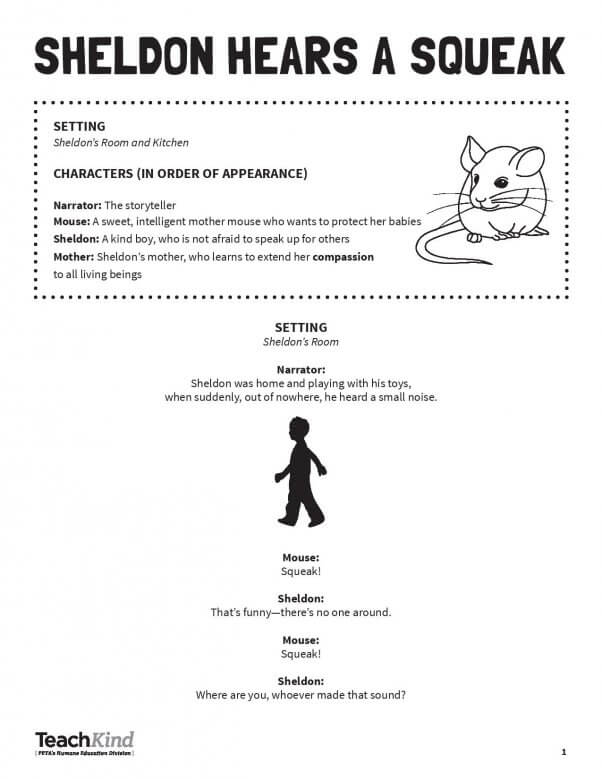
Science Connection: Shadows and Light
Discussion Questions
Use these questions to discuss information about light and shadows with students.
1. What is light?
Answer: Light is a form of energy that moves like a wave.
What are some sources of light?
Answer: The sun, lamps, flashlights, headlights on a car, and celling lights are sources of light.
2. What is a shadow?
Answer: A shadow is created when an object bocks all or some of the light from a light source.
3. What can make shadows?
Answer: Animals, books, desks, trees, buildings—anything that can block light.
4. What causes the formation of a shadow?
Answer: When an opaque or a translucent object comes between a source of light and a surface, that object casts a shadow on the surface.
5. Why was the light able to move through the screen but not the puppet?
Answer: The puppet is opaque, meaning that it blocks all the light. The screen is translucent, meaning that it blocks some of the light. Some things, like the glass in a window, are transparent, meaning that they block no light.
6. What other objects are opaque?
Answer: People, books, desks, trees, buildings, etc.
7. What other objects are translucent?
Answer: Curtains, paper, frosted glass, etc.
8. What other objects are transparent?
Answer: Eyeglasses, drinking glasses, magnifying glasses, etc.
9. Why do you have a shadow?
Answer: Your body is opaque, so it blocks all the light from the sun or other light sources, creating a shadow.
10. What happened to the puppet’s shadow when the puppet was moved closer to the light?
Answer: The shadow got bigger, because the object was blocking more of the light.
11. What happened to the puppet’s shadow when you moved the puppet further from the light?
Answer: The shadow got smaller, because the object was blocking less of the light.
12. What other ways do you use shadow and light in your everyday life?
Answer: You use light to see. You can sit in the shadow of a tree on a hot, sunny day.
Like these ideas? Please share them to inspire other teachers to incorporate compassion for animals in creative ways throughout their curriculum.

